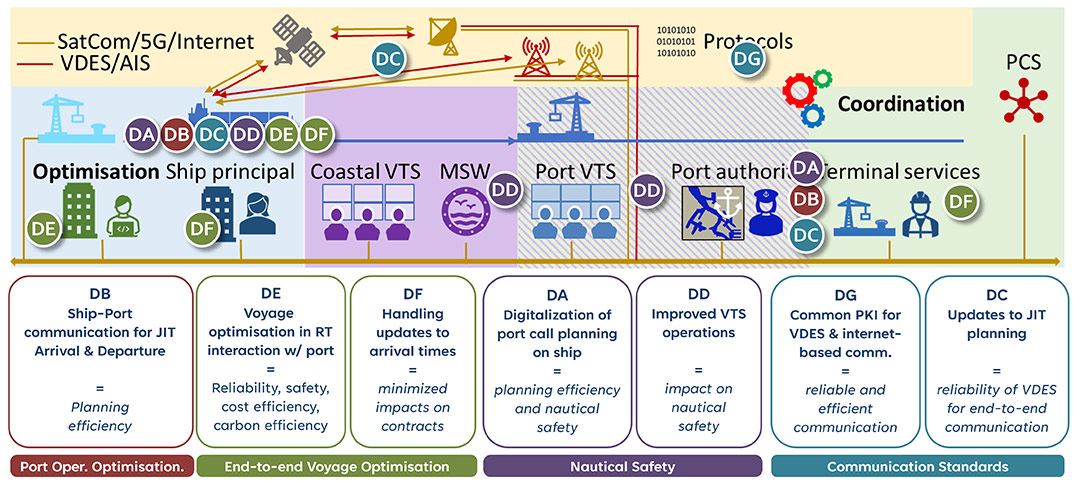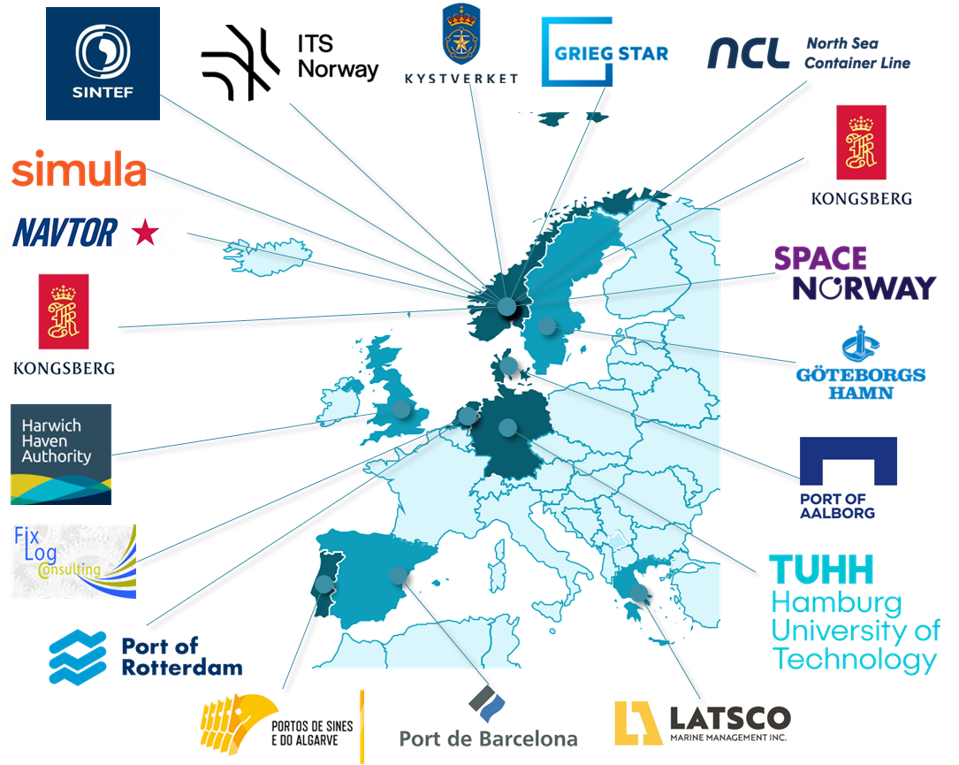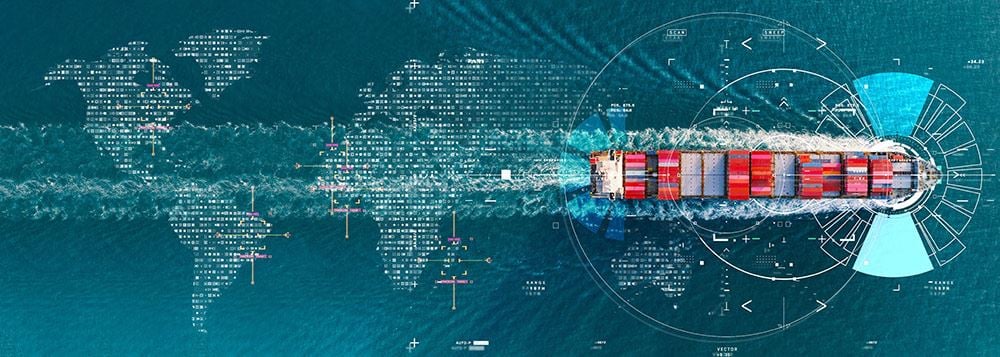Whatever the pathway for a sustainable transition towards net zero emissions from shipping by 2050, more energy-efficient operations remain a prerequisite. This applies to the ship sailing as well as the port call processes. Today, up to 15% of GHG emissions from shipping occur in port area, while a potential saving of around 20% of emissions at sea remains unleashed.
This calls for integrated planning and coordinate actions between ports and ships to enable just-in-time (JIT) arrival, minimizing unnecessary and wasteful fuel, time and resource use.
Optimizing at all levels
Efficient optimization of the voyage requires that planned arrival time in the next port, and as quickly as possible to the berth, is known as early as possible and preferably before departure from the previous port. This requires better coordination between the parties involved in passage planning and the port call process, and removal of important barriers such as inadequate contracts and lack of risk sharing, lack of transparency, inefficient information sharing. Improved efficiency in the port call process also has the potential to increase utilization of the port resources, including anchorages, berths, tugs, pilots, and other assets.
Reduced time at anchorage, and more efficient traffic management, can also significantly reduce negative societal impacts from the port due to reduced area use and noise, in addition to reducing greenhouse gas (GHG) emissions. Furthermore, sharing the information regarding the agreed planned arrival dates and times at port and berth with wider supply chain stakeholders and hinterland logistic service providers, will enable much better synchronization of the hinterland activities with the vessel operations. This will help to further decrease the GHG emissions of transport operation in and around the port.
The DYNAPORT project
The goal of DYNAPORT is to develop new optimization and coordination tools for ports and ships that both reduce the ship's fuel consumption and increases port efficiency with at least 10%. KPIs will be developed to quantify and measure these savings. The tools will be built on information sharing through internationally accepted protocol standards and communication systems to ensure the uptake of DYNAPORT’s solutions internationally. To improve port efficiency as well as port approach safety, the system will integrate the port VTS in arrival and departure planning and execution.
DYNAPORT’s objectives
O1: Port processes and business models. Enable timely, reliable, and efficient information sharing.
O2: Voyage optimisation. Enable dynamic operation planning, improving voyage and port call efficiency.
O3: Improved nautical safety. To optimise safe sailing without disturbing commercial schedules.
O4: Shipping business models & contracts. Better cooperation for JIT arrival/departure, without undue risk for any partner.
O5: Communication standards. To allow cooperation on agreed-on departure and arrival planned times.
O6: Cyber-secure communication. Develop and demonstrate cyber-secure & trusted communication solutions.
O7: Develop KPIs and measure the effectiveness and efficiency of DYNAPORT’s improvements.
O8: Business plans for upscaling.
Does not start from scratch
DYNAPORT's goal is not new and has been addressed through several previous EU projects such as MarNIS, Flagship, Efforts, and the Sea Traffic Management related projects. All projects made important contributions in the area, but generally failed to establish new international agreements on how to improve coordination in ports and between ships and ports. However, lately IMO - the International Maritime Organization, has strengthened its efforts to reduce GHG emissions and are also addressing the cooperation between ports and ships to optimise voyages and JIT arrival (a.k.a. JIT sailing).
The International Taskforce on Port Call Optimisation (ITPCO) was established by several large shipping lines and ports almost ten years ago "to improve and standardize wherever feasible the exchange of nautical, administrative and operational data between ship and shore, ensuring all relevant parties are able to facilitate an efficiently completed vessel port call". Many of the results of the ITPCO have been accepted into primary documentation of the IMO, IHO, BIMCO, IAPH, IHMA and many other leading organisations in the maritime and ports industry as well as in ISO standards.
DYNAPORT’s demonstators
Demonstrations are a critical part of the DYNAPORT project. They will play a vital role in dissemination of results and providing proof of the viability of the proposed concepts. DYNAPORT will perform several and varied demonstration to avoid disruptions in day-to-day port operations and also to get a wider range of responses and results. Most of the demonstrations will be done with more than one port and ship type to provide evidence of how the DYNAPORT concepts work in different sized ports and shipping trades.
The results of the individual demonstrations will be consolidated in an integrated system for simulation and impact assessment, followed by policy and industry recommendations.
Demonstations
Port call planning on ship: To show benefit of digitalisation on planning efficiency and nautical safety
Execute JIT planning ship-port: To show the just-in-time arrival protocols and methods for communication ship-port and optimisation of port call, gain in efficiency in port call planning.
Updates to JIT planning: To demonstrate the reliability of VDES for end-to-end communication.
Improved VTS operations and impact on nautical safety.
End-to-end Voyage optimisation in a dynamic, real-time interaction with ports: For reliable, safe, cost- and carbon efficient voyage.
Updates to arrival times and minimised impacts on contracts. To showcase the application of the port call blueprint and cooperation mechanisms.
Use of common PKI for VDES and internet-based communication: For reliable and efficient communication.
Port call planning on ship: Demonstrate the planning of port call onboard ship, and how digitalizing the port call planning process can improve safety of navigation. Ships from NCL, Grieg Star and Latsco, equipped with Voyage Planners, shall plan and execute port calls at RTM and BCN.
Execute JIP planning ship-port: Demonstrate just-in-time arrival protocols and methods for communication ship-port and optimization of port call.
Updates to JIT planning: Demonstrate and prove that VDES is a viable communication carrier for JiT related information, both in open sea and port approach. The critical issue is to determine applicability and reliability of VDES.

The Consortium
The DYNAPORT partners represent the entire value system targeted by DYNAPORT: the shipping community, port community, communication services and IT, planning and optimisation software providers. Each partner is a stakeholder of DYNAPORT, either as a solution provider or a solution user, and have therefore a strong motivation for the successful deployment of the DYNAPORT solutions.

SINTEF Ocean
Hamburg University of Technology
Simula Research Laboratory AS, Research
ITS Norway, Interest organization
FixLog Consulting
Kongsberg Norcontrol AS,
Space Norway AS
Navtor AS,
Kongsberg Discovery AS
Port of Gothenburg
Sines Port and Logistics
Port de Barcelona
Port of Rotterdam
Port of Harwich
Port of Aalborg
North Sea Container Line AS
Grieg Star AS
LATSCO Marine Management Inc
Norwegian Coastal Authority
Project facts
Project title: Dynamic navigation and port call optimisation in real time
Funding: EU Horizon Europe
EU Horizon Europe Call: HORIZON-CL5-2023-D5-01-13: Integrated real-time digital solutions to optimise navigation and port calls to reduce emissions from shipping
Project type: Innovation action
Duration: 2024- 2026 (36 months)
Budget: 8,8 M€ (7,2 M€ funded)
Consortium: 19 partner, 9 countries
Coordinator: SINTEF Ocean, Norway


